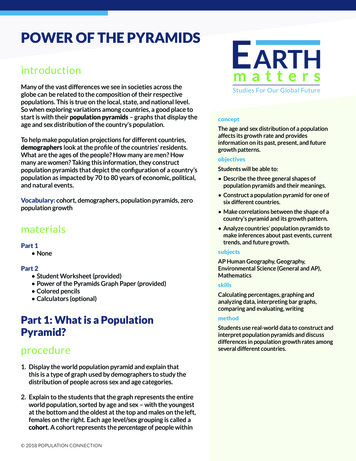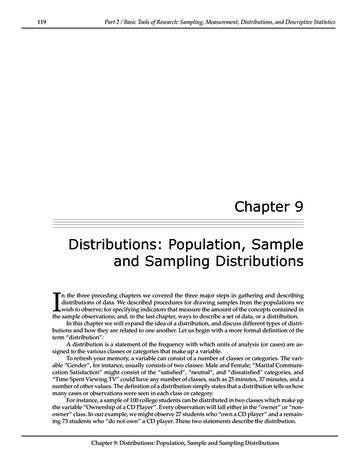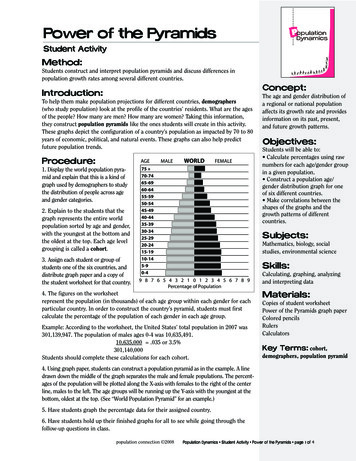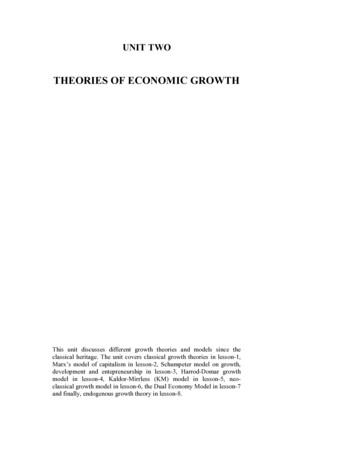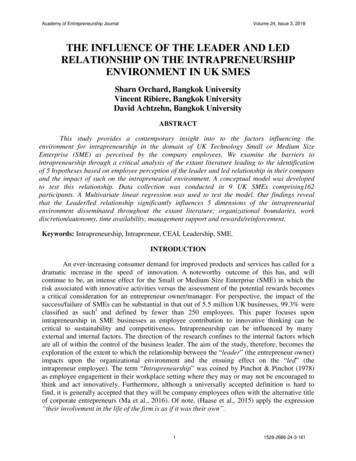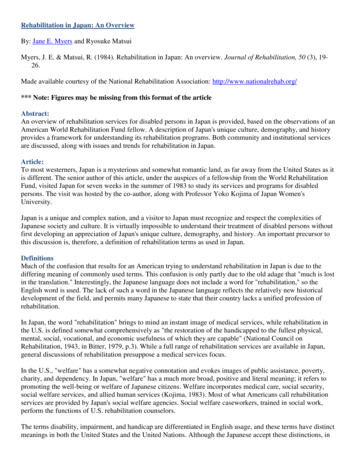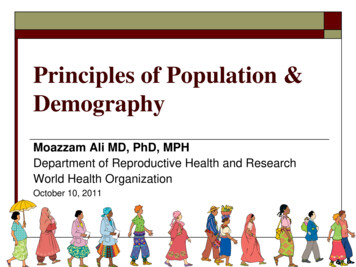
Transcription
Principles of Population &DemographyMoazzam Ali MD, PhD, MPHDepartment of Reproductive Health and ResearchWorld Health OrganizationOctober 10, 2011
Definitions of population & demography and relevantindicatorsWhy family planning is still important Key indicators on family planning MDG, RH Strategy, UNSG StrategyContraceptive PrevalenceUnmet need for FPSpecial target populations groupsNeed for research in population & family planning
Population: definition “Group of individuals of same species livingin the same geographic area at the same time” A population is often defined bydemographers according to the specific needsof the research and researcher. Threeprocesses are relevant to demography: Fertility, Mortality, and Migration
Population: basic concepts There are only two ways to enter a population bybirth and by in-migration.There are two ways to leave a population, bydeath and by out-migration.For example, the population of interest may be thatof students attending a specific university during aspecific year. In this situation, the students are born(i.e., enter) into the population when they enroll, andthey die (i.e., leave) when they graduate
Trends in global population growth1st Billion: 18042nd Billion: 1927 (123 years)3rd Billion: 1960 (33 years)4th Billion: 1974 (14 years)5th Billion: 1987 (13 years)6th Billion: 1999 (12 years)7th Billion: 2011 (12 years)8th Billion: 2023 (12 years)
Projecting futurepopulations Human Population since1980 is J-shaped curvePopulation is increasinghowever growth rate (r) hasstarted to declineProjections for 2050 (2007) Low 7.7 billion High 10.6 billion Most likely 9.1 billion
Reaching the 7 billion mark World Population to surpass 7 Billion in 2011 andwill reach seven billion on 31st October, a milestonethat offers unprecedented challenges andopportunities to all of humanity, according toUNFPA
World population distribution: global overview
Population density Population density The number of individuals of a species per unitarea or volume at a given timeOvals below have same population, and differentdensities
Population density of countries
Effects of overpopulationSome of the global effects of overpopulationinclude: Ultimate shortages of energy sources and othernatural resources, Famine Serious communicable diseases in dense populations Shortage of arable land (where food crops will grow) Little surplus food Mass extinctions of plants and animals as habitat isused for farming and human settlements War over scarce resources such as land area.
Effects of overpopulation High birth ratesLower life expectanciesLower levels of literacyChild povertyHigher rates of unemployment, especially in urbanPoor diet with ill health and diet-deficiency diseases (e.g.rickets)Low per capita GDPIncreasingly unhygienic conditionsGovernment stretched economicallyIncreased crime rates resulting from people stealing resourcesto survive
Demography: historical perspective Demography is the study of human population dynamics.Achille Guillard first used the title on his book:"Elements de Statistique Humaine ou Demographie Comparee". Two Greek roots: demos (people) graphy (branch of knowledge regarding a particular science in thiscase, human populations). Guillard then defined demography as: „the mathematical knowledge ofpopulations, their general movements, and their physical, civil, intellectualand moral state‟ (Guillard 1855:xxvi).
Today demography encompass the determinants and consequences of population changeand is concerned with virtually everything that influences orcan be influenced by: Population SizePopulation growth or declinePopulation processes (levels and trends in mortality, fertilityand migration that are determining population size andchange).Population characteristics (education, religion, or ethnicity)Population structure (how many by age)
Population pyramid: age structure The number and proportion of people at each age ina population
Demographics of specific countries
Demographic stages Pre-industrial Stage Birth and death rates high Modest population growthTransitional Stage Lowered death rate Rapid population growthIndustrial Stage Birth rate decline Population growth slowPost Industrial Stage Low birth and death rates Population growth very slow
Demographic stages
Demographic indicators Because demography is interested in changes inhuman populations, demographers focus on specificindicators of change. Two of the most important indicators are birth anddeath rates, which are also referred to as fertility andmortality. Additionally, demographers are interested inmigration trends or the movement of people fromone location to another.
Fertility and fecundity Fertility, in demography, refers to the ability of females toproduce healthy offspring in abundance. Fecundity is thepotential reproductive capacity of a female. Some of the morecommon demographic measures used in relation to fertilityand/or fecundity include: Crude birth rateGeneral fertility rateAge-specific fertility rateTotal fertility rateGross reproduction rateNet reproduction rate
Replacement level fertility It refers to the number of children that a woman (ormonogamous couple) must have in order to replace theexisting population. Replacement level fertility is generallyset at 2.1 children in a woman's lifetime (this number variesby geographic region given different mortality rates). The reason the number is set to 2.1 children per woman isbecause two children are needed to replace the parents and anadditional one-tenth of a child is needed to make up for themortality of children and women who do not reach the end oftheir reproductive years.
Total fertility rate The total fertility rate (TFR) of a population is theaverage number of children that would be born to awoman over her lifetime if ; (1) she were to experience the exact current agespecific fertility rates (ASFRs) through herlifetime, and(2) she were to survive from birth through the endof her reproductive life. It is obtained bysumming the single-year age-specific rates at agiven time.
World historical and predicted total fertilityrates (1950–2100) UN, 45–20502.172095–21002.03
Trends in TFR 1950-2050
Mortality Mortality refers to the finite nature of humanity: people die.Mortality in demography is interested in the number of deathsin a given time or place or the proportion of deaths in relationto a population. Some of the more common demographicmeasures of mortality include: crude death rate: the annual number of deaths per 1000peopleinfant mortality rate: the annual number of deaths ofchildren less than 1 year old per thousand live birthslife expectancy: the number of years which an individualat a given age can expect to live at present mortality rates
Infant mortality rate by region 1950-2050
Life expectancy at birth by region, 1950-2050
Change in population size
Migration : change in population size
Calculating population changeGrowthrateDeathrateEmigrationrater (b – d) (i – e)BirthrateImmigrationrateBirth (b), Death (d), Immigration (i) and Emigration (e)are calculated per 1000 people
Why Family Planning is still important ?
Family planning can help preventunintended and unwanted pregnancies It has intrinsic benefits to the women themselves,and contributes to child health and survival 33 gender equality and empowermentfulfillment of human rightschild survival,poverty reductionopportunities (e.g. education, economic empowerment)maternal health and survivalEstimated that 27% of maternal deaths can beprevented by meeting unmet need for familyplanning
Current situationon family planningConstraints: Insert file name 3434 26 countries have CPRbelow 20%215 million couples havean unmet need for familyplanningDecreased investment incontraceptive research anddevelopment by industry,despite increased demandActive mis - anddisinformationOpportunities: MDG 5b: Universal accessto reproductive health FP and other SRHservicesRenewed interest insupporting family planninginternationally
MDG 5: improve maternal health 5 A:Reduce by three quarters, between 1990 and 2015, thematernal mortality ratio 5.1 Maternal mortality ratio 5.2 Proportion of births attended by skilled healthpersonnel 5.B: Achieve, by 2015, universal access to reproductivehealth 5.3 Contraceptive prevalence rate5.4 Adolescent birth rate5.5 Antenatal care coverage (at least one visit andat least four visits)5.6 Unmet need for family planning
UN Secretary General's Global Strategy forWomen's and Children's Health: 201036Components Country-led health plans Comprehensive, integratedpackage of essential interventionsand services Integrated care Health systems strengthening Health workforce capacitybuilding Coordinated research andinnovationRole of UN agencies Define norms, regulations andguidance to underpin efforts Help countries align their nationalpractices Work together and with others tostrengthen technical assistance toscale-up Encourage links between sectorsand integration with otherinternational efforts Support systems that trackprogress and identify funding gaps Generate and synthesize researchderived evidence and provide aplatform for sharing
37
Evidence-based packages of interventions toimprove SRH (H4 ) and partners38Health SystemComponentsBenefits and potential impact of interventions,including Family planningHealth system requirementsService delivery recommendationsIndicators
Family planning guidelines and toolsMedical EligibilityCriteriaThe MedicalEligibilityCriteria WheelSelected PracticeRecommendationsCIREReproductive Choicesand Family Planningfor People with HIV4th edition just published!392010DecisionMaking ToolGlobal HandbookNew Guide to familyplanning forhealth careproviders andtheir clients
Indicators on family planning
Contraceptive prevalence rate08 XXX MM41 Contraceptive prevalence is the percentage ofwomen who are currently using, or whose sexualpartner is currently using, at least one method ofcontraception, regardless of the method used. It is usually reported for married or in union women aged 15 to 49. A union involves a man and a woman regularly cohabiting in amarriage-like relationship.
Global contraceptive prevalence rate80.070.060.0Africa50.0CPRAsiaEurope40.0Latin AmericaNorth America30.0Oceania20.008 XXX MM4210.00.01980198519901995YEAR200020052009
Contraceptive prevalence rate in AsiaCPR Trends - Asia90.080.070.060.0ASIACPRCentral Asia50.0Eastern AsiaSouthern Asia40.0South-Eastern Asia30.0Western Asia20.008 XXX MM4310.00.01980198519901995Year200020052009
Trends in childbearing, by regionAverage number of children per 65-1970Latin Americaand theCaribbean2000-2005Source: United Nations, World Population Prospects: The 2004 Revision, 2005.More DevelopedCountries
Diverging trends in fertility reduction8.5Average number of children per 52.1IndonesiaIran1970-1975Pakistan2000-2005Source: United Nations, World Population Prospects: The 2004 Revision, 2005.TurkeyYemen
Rising family planning use, developingcountries60Married Women 15 to 49 Using Any Method53(Percent)382491960197019801990Source: Population Reference Bureau, Family Planning Worldwide 2002 Data Sheet.Late 1990s
Family planning methods, worldwideTraditionalMethodsMale 7%Sterilization3%Other ModernMethods1%Not Using39%FemaleSterilization21%Male Condom5%Injectable orImplant3%IUD14%Pill8%Note: Total exceeds 100 due to rounding.Source: United Nations Population Division, World Contraceptive Use 2005.
Family planning methods, Sub-Saharan AfricaIUD Condom5%5% Rhythm16%Pill21%Withdrawal5%Married Women 15 to 49 UsingFamily Planning, Late 1990sFemaleSterilization11%Note: Total exceeds 100 percent due to rounding.Source: Population Reference Bureau, Family Planning Worldwide 2002 Data Sheet.OtherTraditional11%
Defining unmet need for family planning The number of women with unmet need for family planningWomen of reproductive age who are married or in a unionX 100 Understood by many as– the percentage of women who are not currently using amethod of family planning and want to stop or delaychildbearing Complete calculation– Is complex– Is not widely understood– Is difficult to calculate using data other thanDemographic and Health Surveys (DHS)
Unmet needs for family planning As unmet need is increasingly used for– advocacy– development of family planning policies– implementation and monitoringAnd has been adopted as a Millennium Development Goal(MDG) indicator (target 5b, indicator 5.6) Understanding this indicator has become crucialNew urgency to find a definition that can be appliedconsistently over time and across DHS, MICS, RHS, andother surveys
Unintended birthsBirths Reported by Women as Either Unwanted or Wanted agascar 05Source: DHS STATcompiler: accessed online at www.measuredhs.com/statcompiler on June 14, 2006.
Wanted Births, WorldwideNot Wanted11%Recent Births, byMother’s Attitude,Late 1990sWantedLater16%Wanted73%Note: Estimates based on approximately 60 percent of births worldwide.Source: Population Reference Bureau, Family Planning Worldwide 2002 Data Sheet.
Global unmet need for family planning30.025.0WORLDAFRICAUnmet Need20.0ASIA15.0Southern EuropeLATIN AMERICA AND THECARIBBEAN10.0NORTHERN AMERICA08 XXX MM535.00.0199019952000Year20052009
Reasons for high unmet need Perceived lack of exposure to pregnancy was the most commonreason cited Between one-third and two-thirds of women with unmet needsaid they were never or infrequently having sex. Believed they could not become pregnant because of menopause,breastfeeding, or another reason.Opposition to family planning (by women, their husbands, or others).Gender imbalance – Men‟s unmet need tends to be lower because men want to havemore children (or sooner) than do womenMethod-related problems were cited by about one-third of womenwith unmet need. Problems related to side effects and health concerns Cost and access also mentioned.Lack of knowledge about methods or sources of supply
Special groups: lack of Access to family planning 215 million couples worldwide don‟t have access to familyplanning Groups without access: Adolescents Unmarried women Women postponing their first pregnancy People with disabilities Poor, especially people in rural areas and urban slums Migrants Postpartum women
Why to do the research in family planning
Why do we need more research? High unmet need High percent of non-use Existing methods do not meet the needs of all Some are difficult to use consistently and correctly High typical use failure rates of temporary methods Side effects or fear of side effects High discontinuation of temporary methods Changing needs and desires over reproductive lifespan
we can improve upon existing methods Less expensiveEasier to use in a compliant wayHighly effective in typical useSafe and AcceptableRapidly reversible Convenient and easy to use Use in chronic disease statesProvide additional health benefitsEasier to deliver in service settings: availability, affordabilityand acceptabilityUser-independent (Forgiving of misuse)Provided by CHWs (task shifting), or provider independent
or develop new methods that could begame changers Male methods that are practicalNon-condom approaches for dual protectionNon-surgical sterilizationPeri-coital methodsImmuno-contraceptivesNovel and/or non-hormonal contraceptives (daily orlong acting)Methods with non-contraceptive health benefits
Research is important Research can play a critical role in responding to thechallenge of unmet need for family planning,especially during periods when resources are limited. To fill the knowledge gap regarding contraceptivetechnology & safety, and address implementationissues related to improving contraceptive uptake,removing barriers and increasing acceptability. Aims to develop new innovations in service deliveryand contraceptive methods.
Research prioritization for next decade Research priorities must be reviewed andupdated periodically to maintain theirrelevance in a fair and transparent way.
CHNRI Prioritization Process:Setting the agenda The CHNRI priority settingprocess aims to include notonly research that producesnew knowledge, but alsoresearch that focuses onimplementation of existingknowledge. The CHNRI process issystematic. This diagramdetails the process ofprioritization.
CHNRI process: research prioritizationResearch InstrumentBasic EpidemiologicalResearchResearch AvenueMeasuring the unmet needUnderstanding barriers to useEvaluating existingcontraceptivesHealth Policy andSystems researchStudy the capacity to reduceobstacles to use ofcontraceptivesStudying capacity to deliverefficacious interventionsResearch to improveexisting interventionsResearch to improvedeliverabilityResearch to improve affordabilityResearch to improvesustainabilityResearch for developmentof new contraceptivetechnologiesBasic researchClinical researchPublic health researchResearch Option(Research Project)Research Question(research papers)(list research options withineach research avenue)(list research questionswithin each research option)
Conclusion Use in reducing MMR is under emphasized.Potential to reduce poverty and hunger and avert32% of all maternal deaths and nearly 10% ofchildhood deaths.Fall in total fertility rate from 6 to 3.Need for political willingness and commitment.Call for renewed commitment by donors and thepotential of commercial sector through partnershipsshould be explored.
Ultimate shortages of energy sources and other natural resources, Famine Serious communicable diseases in dense populations Shortage of arable land (where food crops will grow) Little surplus food Mass extinctions of plants and ani

